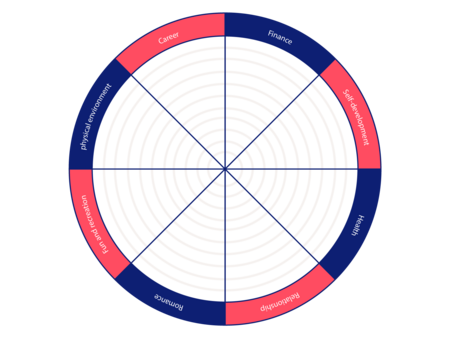

Wheel of life coaching: Everything you need to know
The wheel of Life Coaching is the ultimate coaching tool to provide a visual representation of conflicting demands on a persons time.


The wheel of Life Coaching is the ultimate coaching tool to provide a visual representation of conflicting demands on a persons time.
The Wheel of Life is regarded by many as the ultimate coaching tool, offering endless versatility to gain an instant understanding of a client’s life. It may appear to be a basic worksheet, but it can be adapted to almost any situation, making it the most flexible implement in the methodology of a life coach. Providing a visual representation of the conflicting demands on a person’s time can help clients instantly see where they lack balance or fulfilment.
Frequently referred to as a tool used in life coaching to assess priorities’, the Wheel of Life offers so much more than simple assessment. The helicopter view gives clients self-awareness, allowing them to invest in their life coaching journey because they can physically see the direction they need to progress in. It also works as a feedback mechanism because it can be completed repeatedly to review and evaluate their personal development.
Also known as ‘the wheel of life coaching’ or ‘the life balance wheel’, it is used to understand how areas in your life are balanced and to help achieve equilibrium. Unsurprisingly, given its usefulness to life coaches, the tool was developed by a man considered to be one of the pioneers of the life coaching movement. Paul J. Meyer founded the Success Motivation Institute in 1960 and developed the Wheel as a tool to be used to focus on goal-setting and creating action plans.
Essentially the wheel of life displays a breakdown of the different areas that are crucial for creating balance, normally 8-10 different categories. Clients rate their satisfaction with each area and mark it on the image. Whilst the segments can be varied to create different versions of the wheel, they tend to be similar to the following:

Once a client has completed the wheel of life exercise, the chart will look ‘uneven’ as the client is unlikely to have a similar level of satisfaction in each area. This will enable the coach and client to work together to set goals for improvement and create an action plan to enhance the areas where satisfaction is low.
Using the results the wheel has demonstrated, the coach then has directions for which areas to explore in more depth. A useful technique is to ask the client what they think of their life prior to completing the Wheel so that they can compare it to their original opinion. Following this up with further questions will provide greater detail;
Following this, the coach and client can work together to come up with the steps required to reach the client’s goal.
The ease of use and speed of the Wheel of Life are some of the reasons it’s so valued by coaches, but it can also be tailored to many different situations for different types of life coaches. It can be useful for:
Working toward a promotion or changing career – the segments can be amended to reflect the skills and experiences needed to progress at work or begin something new. This will help the client to highlight areas of strength and weakness and improve their experience.
As a Visualisation / Manifestation board – by writing aspirations for each of the segments, the client can use the wheel to picture what they want their life to look like. They can even add photos or images from magazines into each segment to help them to visualise their life goals.
When meeting with a potential coaching client – in an industry where the personal connection is so vital, many life coaches will offer a free session initially. Obviously, the purpose of this is to see if you can build a rapport and if the client’s aspirations are a good match for the coach’s skills. But it’s also important to make an impact and demonstrate quickly what you could do. Undertaking the Wheel of Life assessment can rapidly demonstrate areas of imbalance and clarify the goals a client could work towards in their coaching sessions. Creating a wheel of life can be a great activity when meeting with a potential client.

Meeting with prospective business partners – Creating a Wheel of Life in the initial stages of a business partnership can be an incredibly useful activity. Undertaking a collaborative task will reveal each other’s working style so you can decide if you’re likely to work effectively together. It will also allow you both to show clearly how you envision the partnership and identify areas where your strengths and weaknesses lay.
The Wheel of Life is an extremely valuable tool but it’s worth remembering the following caveat; life is continually changing. You will never achieve a permanent state of stability, the natural volatility of life will always cause imbalance sometimes. Regularly undertaking the Wheel of Life can help you stay on top of this and react to instability quickly. But the end goal should never be ‘achieving’ balance, but moving towards it.